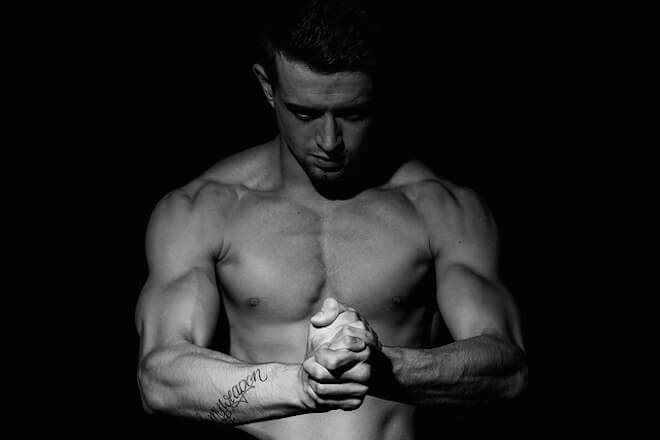Everyone wants to have bodybuilder’s strength and impressive muscle tenacity because honestly majority of sports requires strong muscles that could give you an edge over other competitors. However, this isn’t feasible. Because, the bodybuilder type muscle mass comes with a compromise on agility, speed, flexibility and mobility. This doesn’t mean that the bodybuilders are seriously lacking on these attributes. But, their performance in the mentioned attributes is pretty limited.
However, that doesn’t mean we can’t take a few moves out of bodybuilding. After all, the bodybuilding has been precursor for the strength training that has become an integral part of every sport. The bodybuilders are extremely efficient in building strong and bigger muscles, which in proportion can add explosiveness and power to your arsenal. It can take your game to the next level.
Not all bodybuilding moves are well suited for the athletes. Doing endless bicep curls or any other isolation exercises won’t do any good. The best suited exercises for athletes are those that engage multiple muscle groups at the same time, build overall strength and power. With these five exercises, you will burn fat like an athlete and build muscles like a bodybuilder.
-
Barbell Squat With Elevated Heels
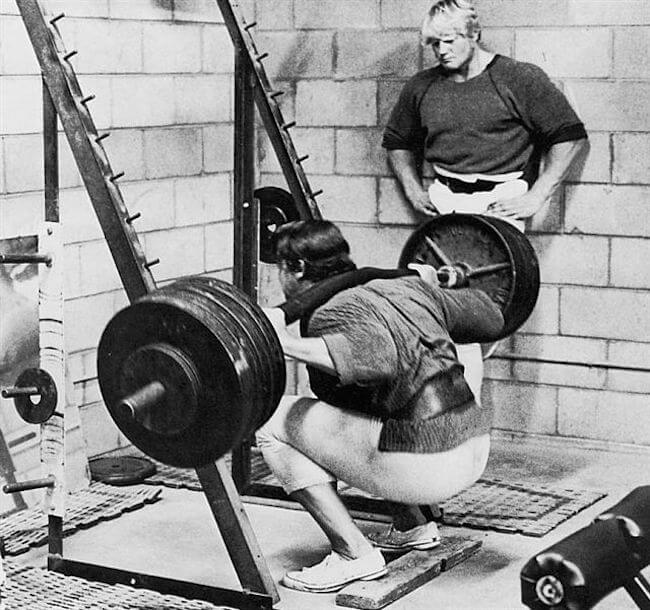
The standard squat, we all know is one of the best compound exercises. It works almost every lower body muscle, some are used for facilitating the overall movement, while other work as stabilizers. The squat also has a reputation as a fantastic fat torching routine by engaging the most number of muscles possible. The elevated heels variation keeps all these great benefits of the squats and add couple of other benefits. This variation adds depth to the squat. The knees can pass the toes without any risk of injury or knee problems. This also increases the range of motion and is natural movement that you use in your daily life such as climbing stairs.
Also, the knees going past the toes increases vastus medialis recruitment. The vastus medialis is an extensor muscle located medially in the thigh that extends the knee. Among other things, this muscle is involved in knee extension. It can also prevent the mal-tracking of the patella, which can be caused due to fatigue. And, the subsequent prevention of mal-tracking of the patella can reduce the risk of knee injuries.
Position a pair of 25 pound weight plates under your heels. The feet should be around shoulder width apart. Now, place a barbell over your shoulders and grab it with an overhand grip. Squeeze your shoulder blades together and tighten your core to maintain balance and stability while doing the exercise.
Now, slowly bend your knees and sit into the squat by lowering your hips. Keep on descending, until your knees are bent at 90 degree angle and thighs are parallel to the floor. Remember that you have to maintain an upright posture, be extra cautious about rounding your back. It can lead to serious back problems and injury. Pause for a second at the bottom and then, drive your heels into the ground and push your body back to the starting position.
-
Supine Row
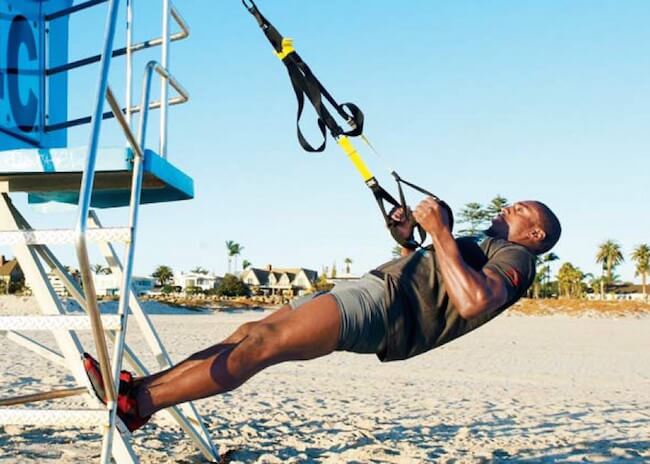
The most popular back exercises are those, done using the weights. The bodyweight exercises are plainly ignored. Their simple movement and simple premise makes people underrate them too quickly and too often. After all, how can a simple bodyweight exercise build more powerful and stronger muscles than those exercises in which we lift heavy weights? And, this is where most people are wrong. No exercise can build functional strength and power as bodyweight exercises.
The bent rows and lat pulldown are great for developing a strong back. But, when it comes to developing the back strength in the horizontal plane, there is no substitute of supine row, also known as inverted row in some training circles. For athletes, it is very important to train the body in multiple planes as you are pulling in different directions.
Those, who have never done this exercise before should start with the feet on the ground. With passing workouts and days, as you build your strength, you can start moving your feet up and can eventually progress to doing supine rows with feet elevated on bench or ball and body parallel to the ground. The instructions on how to do supine row is listed below assuming that you are a beginner.
In the Smith machine rack, place a barbell at about waist height. Now, position yourself below the bar and grab the bar with shoulder width grip. Squeeze your abs and engage your back. The body should be in straight line. Let your body hang down by fully extending your arms. This is the starting position.
Now, by flexing your elbows, pull your chest towards the bar. Pinch your shoulder blades together as you reach the top of the movement. Remember, at this point, your chest should be touching the bar. Hold the position for two seconds and then, steadily and slowly, lower your body to the starting position. Remember, the body should be held absolutely straight, no sagging butt or body curved upwards. And, the movement should be slow and controlled.
-
Barbell Stiff-Legged Deadlift
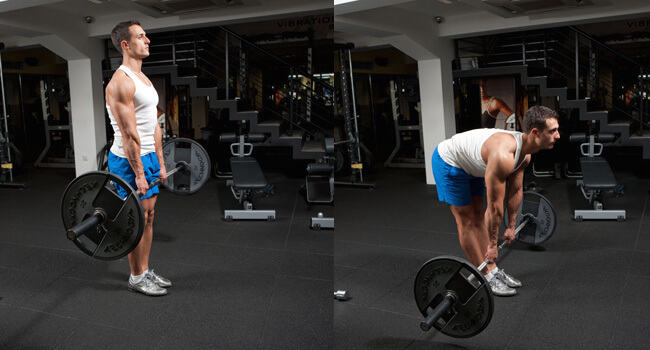
This is an excellent exercise to build stronger and bigger hamstring muscles. It extensively targets your hip and trunk extensors, which include the gluteus maximus and hamstring muscles and the erector spinae and deep spinal muscles, respectively. Along with making one of the biggest thigh muscles stronger, doing barbell stiff legged deadlift cuts down the risk of hip, thigh and lower-back injuries. It can also help in preventing or minimizing the notorious lower back pain.
However, often coaches advise against doing this exercise because they are concerned about the strain, it puts on your back. However, if you have an advanced fitness level, then you need not shy away from this exercise, which is the great way to build the strong posterior leg muscles that are primary workers in powering your run.
Grab a barbell with an overhand grip, the palms facing down. Now, if you are going to lift heavy weight, it would be better that you use wrist wraps. Stand with your back straight and core tightly squeezed. The feet should be about shoulder width wide, you can also opt to stand in a narrower stance. However, be careful against using a too narrow stance as it will put stress on your knees. The knees should be slightly bent. This is the starting position.
While keeping the knees static, bend at the hips and lower the barbell to over the top of your feet. Remember the back should be kept straight throughout the movement. Rounding the back can cause serious back problems. Keep going lower as if you are going to pick something off the floor, stop when you feel a stretch on the knees. Breathe in as you perform this movement. The beginners can bend until their torso is parallel to the ground.
Pause briefly at the bottom of the movement. By extending your hips, start bringing your torso back to the starting position. Breathe out as your perform this movement. If barbell is too difficult for you, you can opt to do this exercise with dumbbells or smith machine.
-
Military Press
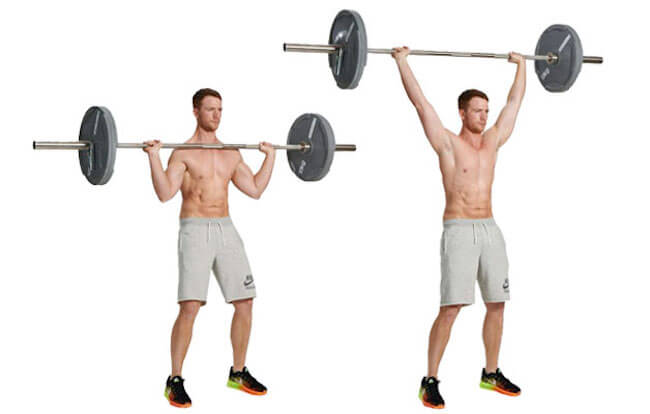
The good old military press is a great exercise for all-round shoulder muscles development. And, as a bonus, the triceps and core is engaged as well. The military press is well known for building impressive upper body physique. But, it is much more than that. Similar to the squats, the military press is a compound exercise. It engages the upper pectoral muscles near your collarbone, lateral deltoids on top of each shoulder, the middle and lower trapezius in your back, the triceps in the back of your upper arms, and the serratus anterior on each side of your upper torso. The upper trapezius in your neck, long head of the triceps and short head of the biceps are engaged as stabilizers as well.
Place a barbell in the squat rack and load it with appropriate weight. Now, grab the barbell with a pronated (palms facing forward) grip. The grip should be slightly wider than shoulder width. Bend the knees slightly and lift the barbell onto your collarbone. Take a step back from the rack. The feet should be spaced around shoulder width apart.
With the correct grip, lift the barbell up over your head by locking your arms. The barbell should be held slightly in front of your head. This is the starting position. Now, slowly and in controlled movement, lower the barbell to the collarbone. Breathe in as you accomplish this movement. Breathe out as you again push the barbell back up over the head.
You can perform this exercise in a seating position as well. It could be beneficial for those suffering from lower back problems. Some people also prefer to do behind the neck variation of the exercise. However, it is advisable to stay away from this variation as it is particularly hard on the rotator cuff and neck muscles.
-
Parallel Dips

Depending on your body’s inclination during the exercise, this is an excellent exercise for building a stronger chest or sculpting triceps. And, it can work both at the same time. Along with these two muscles, the parallel bar dips also engages your shoulders and core to assist in the motion of the exercise. To be precise, the parallel dips puts emphasis on triceps brachii, anterior deltoids in the front of the shoulders and the pectoralis major and pectoralis minor of the chest. The rhomboids of the upper back, the latissimus dorsi, which runs along the back of the ribs and the levator scapulae, which is a small muscle along the neck are the support muscles.
Mount the parallel bars and straighten your arms. The shoulders should be directly above the wrists. Engage your core and maintain straight hips, which means that the body should be in straight line, no bending at the waist. You can cross your ankles for greater stability. Now, slowly lower your body by bending the elbows. During this movement, you will feel a stretch in your shoulders. Lower your body down until the shoulders are lower than elbows or in-line with them. On reaching that point, pause for a moment and start pushing your body up into the starting position by extending your arms.
If you want to engage your chest more, then you can opt to lean your body slightly forward. To put more emphasis on the triceps, you can straighten out your feet and place them on a bench. Remember the movement throughout the exercise should be slow and controlled. And, all the time, keep your back straight and torso squeezed in.
